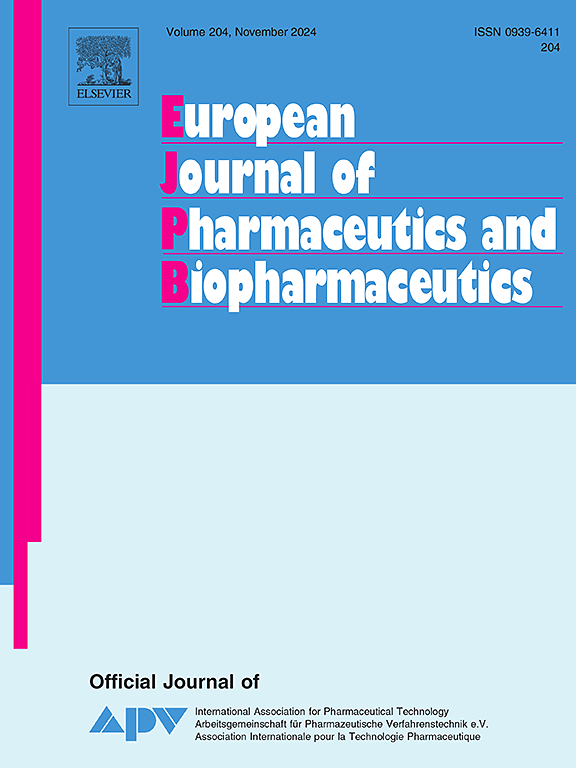用于生物制药药品无菌灌装加工的管道对汽化过氧化氢的吸收。
IF 4.4
2区 医学
Q1 PHARMACOLOGY & PHARMACY
European Journal of Pharmaceutics and Biopharmaceutics
Pub Date : 2025-02-01
DOI:10.1016/j.ejpb.2024.114618
引用次数: 0
摘要
生物制药产品的无菌灌装需要a级洁净室环境,最好在C级环境中使用隔离器。在使用汽化过氧化氢(VHP)开始灌装过程之前对隔离器进行净化,并根据产品对VHP氧化的敏感性,在预定义的残余VHP水平(例如,低于0.5 ppm)开始灌装。制造设备和消耗品,包括灌装组件,在去污周期期间或之后或生产线中断后暴露于VHP。我们在实验室规模的模型隔离器中研究了管道对VHP的吸收,以评估管道性能的影响,包括接触材料、管道尺寸、供应商和VHP暴露(浓度和暴露时间)。利用Amplex Red过氧化氢法定量分析了从管道中释放到溶液中的H2O2,结果表明,H2O2浓度随着管壁厚度的增加而线性下降,随着表面体积比的增加而增加。我们进一步得出结论,在测试条件下,热塑性弹性体和热塑性硫化管没有显示出任何可测量的VHP吸收,而根据管材和供应商的不同,不同的铂固化硅胶管有显著的VHP吸收。我们在GMP生产隔离器设置中进一步验证了结果。根据我们的研究结果,我们建议评估隔离器中用于灌装加工的填充管的VHP吸收,以减少活性药物成分或辅料氧化的风险。本文章由计算机程序翻译,如有差异,请以英文原文为准。

Vaporized Hydrogen Peroxide Uptake by Tubing used for Aseptic Fill-Finish Manufacturing of Biopharmaceutical Drug Products
Aseptic filling of biopharmaceutical products requires a grade A cleanroom environment, preferably ensured by isolators in grade C surroundings. Isolators are decontaminated before the start of filling processes using vaporized hydrogen peroxide (VHP) and filling starts at pre-defined residual VHP levels (e.g., below 0.5 ppm) depending on product sensitivity towards VHP oxidation. Manufacturing equipment and consumables, including filling assemblies, are exposed to VHP during or after the decontamination cycle or after line interruptions. We studied the VHP uptake by tubing in a lab-scale model isolator to evaluate the impact of tubing properties including contact material, tubing dimensions, suppliers, and VHP exposure (concentration and exposure time). Quantifying the release of H2O2 from the tubing into solution using an Amplex Red Hydrogen Peroxide Assay, showed that H2O2 concentrations decreased linearly with an increase in wall thickness and increased with higher surface to volume ratio. We further conclude that thermoplastic elastomer and thermoplastic vulcanizate tubing did not show any measurable VHP uptake for the tested conditions, whereas significant VHP uptake occurred in different platinum cured silicone tubing depending on tubing material and supplier. We further verified the results in a GMP manufacturing isolator setting. Based on our findings, we recommend to evaluate VHP uptake of filling tubing used for fill-finish manufacturing in isolators, to reduce the risk of oxidation for active pharmaceutical ingredients or excipients.
求助全文
通过发布文献求助,成功后即可免费获取论文全文。
去求助
来源期刊
CiteScore
8.80
自引率
4.10%
发文量
211
审稿时长
36 days
期刊介绍:
The European Journal of Pharmaceutics and Biopharmaceutics provides a medium for the publication of novel, innovative and hypothesis-driven research from the areas of Pharmaceutics and Biopharmaceutics.
Topics covered include for example:
Design and development of drug delivery systems for pharmaceuticals and biopharmaceuticals (small molecules, proteins, nucleic acids)
Aspects of manufacturing process design
Biomedical aspects of drug product design
Strategies and formulations for controlled drug transport across biological barriers
Physicochemical aspects of drug product development
Novel excipients for drug product design
Drug delivery and controlled release systems for systemic and local applications
Nanomaterials for therapeutic and diagnostic purposes
Advanced therapy medicinal products
Medical devices supporting a distinct pharmacological effect.

 求助内容:
求助内容: 应助结果提醒方式:
应助结果提醒方式:


